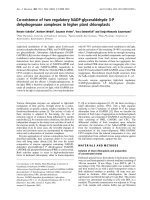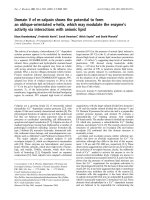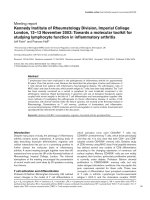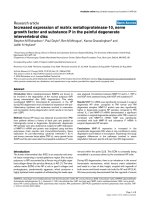Báo cáo y học: "First isolation of two colistin-resistant emerging pathogens, Brevundimonas diminuta and Ochrobactrum anthropi, in a woman with cystic fibrosis: a case report" potx
Bạn đang xem bản rút gọn của tài liệu. Xem và tải ngay bản đầy đủ của tài liệu tại đây (179.43 KB, 4 trang )
BioMed Central
Page 1 of 4
(page number not for citation purposes)
Journal of Medical Case Reports
Open Access
Case report
First isolation of two colistin-resistant emerging pathogens,
Brevundimonas diminuta and Ochrobactrum anthropi, in a woman
with cystic fibrosis: a case report
Magalie Menuet
1
, Fadi Bittar
1
, Nathalie Stremler
2
, Jean-Christophe Dubus
2
,
Jacques Sarles
2
, Didier Raoult
1
and Jean-Marc Rolain*
1
Address:
1
URMITE UMR 6236, CNRS-IRD, Faculté de Médecine et de Pharmacie, Bd Jean Moulin, 13385 Marseille cedex 05, France and
2
Département des Maladies respiratoires, centre de Ressources et de compétences pour la Mucoviscidose Enfants (CRCM), Hôpital Timone,
Marseille, France
Email: Magalie Menuet - ; Fadi Bittar - ; Nathalie Stremler - ;
Jean-Christophe Dubus - ; Jacques Sarles - ; Didier Raoult - ;
Jean-Marc Rolain* -
* Corresponding author
Abstract
Introduction: Cystic fibrosis afflicted lungs support the growth of many bacteria rarely implicated
in other cases of human infections.
Case presentation: We report the isolation and identification, by 16S rRNA amplification and
sequencing, of two emerging pathogens resistant to colistin, Brevundimonas diminuta and
Ochrobactrum anthropi, in a 17-year-old woman with cystic fibrosis and pneumonia. The patient
eventually responded well to a 2-week regime of imipenem and tobramycin.
Conclusion: Our results clearly re-emphasize the emergence of new colistin-resistant pathogens
in patients with cystic fibrosis.
Introduction
Cystic fibrosis (CF) is one of the most common auto-
somal-recessive hereditary diseases in Europeans and is
characterized by disorders of the respiratory tract and pan-
creas, and exacerbations of pulmonary infections. A lim-
ited number of organisms are responsible for these
infections, with Staphylococcus aureus and Pseudomonas aer-
uginosa being of primary importance. Recent studies,
using molecular approaches, have identified uncommon
bacteria and/or novel pathogens in patients with CF [1]
including strains resistant to colistin such as Stenotropho-
monas maltophilia, Achromobacter xylosoxidans, Burkholderia
cepacia and Inquilinus limosus [2]. While the frequency of
infection with these species is believed to be relatively low
and their significance unclear, they present a real chal-
lenge to diagnostic laboratories, as they are difficult to
identify and often misidentified as belonging to the Bur-
kholderia cepacia complex [1,3]. We report the isolation
and identification, by 16S rRNA sequencing, of two
emerging pathogens resistant to colistin, Brevundimonas
diminuta and Ochrobactrum anthropi in a 17-year-old
patient with cystic fibrosis and pneumonia. The study was
approved by the local ethics committee (IFR48).
Case presentation
A 17-year-old woman with cystic fibrosis, and with diabe-
tes and persistent colonization of the respiratory tract with
Staphylococcus aureus since childhood was admitted in
Published: 5 December 2008
Journal of Medical Case Reports 2008, 2:373 doi:10.1186/1752-1947-2-373
Received: 11 October 2007
Accepted: 5 December 2008
This article is available from: />© 2008 Menuet et al; licensee BioMed Central Ltd.
This is an Open Access article distributed under the terms of the Creative Commons Attribution License ( />),
which permits unrestricted use, distribution, and reproduction in any medium, provided the original work is properly cited.
Journal of Medical Case Reports 2008, 2:373 />Page 2 of 4
(page number not for citation purposes)
October 2006 to our specialized centre for a respiratory
infection with dark sputum, asthenia, fever (38.5°C) and
a loss of weight of 4.5 kg. On examination, the patient had
shortness of breath and diffuse crepitations in both lungs.
The oxygen saturation on air was 92% and her chest X-ray
showed a diffuse bronchitis syndrome with bronchial dis-
tension in the right lung apex and left lung base. There was
no pleural effusion. Relevant laboratory findings included
a white blood cell (WBC) count of 18,380/mm
3
with
82.8% polymorphonuclear cells (PMNs), a platelet count
of 618,000/mm
3
, C-reactive protein (CRP) of 57 mg/litre,
fibrinogen of 5.17 g/litre and whole blood glucose of 9
mmol/litre. An admission sputum sample was plated
onto Columbia colistin-nalidixic acid (CNA) agar, choco-
late Poly ViteX agar, MacConKey agar (bioMérieux, Marcy
l'Etoile, France), CEPACIA agar, and SABOURAUD agar
(AES laboratory, Combourg, France). Direct Gram stain-
ing of the sputa showed numerous PMNs (>25 cells/
field), Gram-positive cocci, and infrequent epithelial cells
(<10 cells/field). Apart from 10
7
CFU/ml methicillin-sus-
ceptible S. aureus, two different Gram-negative rods (oxi-
dase and catalase positive) were isolated from CEPACIA
agar at 10
3
CFU/ml after 3 days of incubation. Using API
20NE (bioMérieux, Marcy l'Etoile, France), two isolates
initially identified as Weeksella virosa /Empedobacter brevis
(Code 0010014, 84.5% probability) and Ochrobactrum
anthropi (code 1641344, 98.9% probability) were defini-
tively identified as B. diminuta (100% homology with B.
diminuta strain DSM 1635, GenBank accession number
X87274
) and O. anthropi (100% homology with O.
anthropi strain W24, GenBank accession number
EF198140
), respectively, after amplification and sequenc-
ing of the 16S rRNA gene as previously described [4].
Although there is neither clear consensus nor guidelines
for antibiotic susceptibility testing (AST) of these two bac-
teria, AST was performed using VITEK 2 Auto system
(bioMérieux, Marcy l'Etoile, France) and disc diffusion
methods. The B. diminuta was resistant to amoxicillin,
amoxicillin/clavulanic acid, ceftazidime, ciprofloxacin,
trimethoprim/sulphamethoxazole and colistin but
remained susceptible to ceftriaxone, ticarcillin, ticarcillin/
clavulanic acid, imipenem, amikacin, tobramycin, gen-
tamicin, isepamicin, rifampicin, and piperacillin/tazo-
bactam. The O. anthropi was resistant to amoxicillin,
amoxicillin/clavulanic acid, ticarcillin, ticarcillin/clavu-
lanic acid, ceftazidime, ceftriaxone, piperacillin/tazo-
bactam and colistin but remained susceptible to
ciprofloxacin, imipenem, amikacin, tobramycin, gen-
tamicin, isepamicin, trimethoprim/sulphamethoxazole
and rifampicin. The patient was initially treated with
ceftazidime (2 g 4 times/day) and nebulized tobramycin
(300 mg/day) for 2 weeks. The treatment was switched to
intravenous imipenem (4 g/day) and tobramycin (320
mg/day) for 2 weeks with dramatic improvement. Two
weeks later, the patient was clinically well and sputum
culture yielded a mixed oral population. B. diminuta and
O. anthropi were not cultured again in 5 sputa investigated
during 7 months of follow-up.
Discussion
B. diminuta is a non-lactose-fermenting environmental
Gram-negative bacillus previously assigned to the genus
Pseudomonas (Figure 1) that has been occasionally impli-
cated in clinical situations in immunocompetent and
immunocompromised hosts including bacteraemia, uri-
nary infection and emphysema [5,6]. In a study by Kiska
et al. [3], B. diminuta was isolated in a patient with cystic
fibrosis, after being misidentified as B. cepacia, but the
identification was not performed using molecular meth-
ods and the patient's clinical condition was not reported
[3]. O. anthropi is a Gram-negative non-fermenting bacil-
lus widely distributed in the environment that has rarely
been reported as a human pathogen. It has been impli-
cated in several clinical situations in immunocompetent
and immunocompromised hosts including osteochondri-
tis, necrotizing fasciitis, endophthalmitis, cellulitis, sepsis,
chest wall abscess, osteomyelitis, endocarditis and pelvic
abscess [7-9]. O. anthropi is characterized by a broad spec-
trum of antibiotic resistance and is believed to be natu-
rally susceptible to colistin [10] whereas there are
currently no available data for AST of B. diminuta. It
should be noted that our patient received a course of col-
istin to treat a A. xylosoxidans colonization 10 months
before the onset of this pneumonia. This may have con-
tributed to the selection of these two colistin-resistant bac-
teria in our patient. We believe that these two colistin-
resistant pathogens were the main cause of her acute
pneumonia. Although S. aureus may also partially partici-
pate in the pathogenic process, O. anthropi and B. diminuta
were isolated during this pneumonia. Moreover, the
patient did not improve initially with an effective antibio-
therapy against S. aureus (ceftazidime) and improved
using an effective antibiotic treatment against the two col-
istin/ceftazidime-resistant strains suggesting a role of one
or both colistin-resistant strains as an agent of lower res-
piratory tract infection in this patient.
Conclusion
Our results clearly re-emphasize the emergence of new
colistin-resistant pathogens in patients with cystic fibrosis
as recently reported for Inquilinus limosus [2]. The
increased clinical use of nebulized colistin in patients
with cystic fibrosis may select specific colistin-resistant
bacteria. Furthermore, the use of Burkholderia cepacia com-
plex selective agar associated with molecular approaches
may allow the identification of emerging colistin-resistant
pathogens in patients with cystic fibrosis.
Abbreviations
AST: antibiotic susceptibility testing; CF: cystic fibrosis;
CNA: Columbia colistin-nalidixic acid; CRP: C-reactive
Journal of Medical Case Reports 2008, 2:373 />Page 3 of 4
(page number not for citation purposes)
Phylogenetic tree based on 16S rRNA sequencesFigure 1
Phylogenetic tree based on 16S rRNA sequences. The information presented includes bacterial species or phylotype and Gen-
Bank accession number. Footnote: Bacteria that are given in bold have been described as colistin-resistant in patients with
cystic fibrosis.
Pseudomonas putida DQ989291
Pseudomonas fluorescens DQ916132
Pseudomonas stutzeri AY905607
Pseudomonas aeruginosa DQ889450
Acinetobacter baumannii AY7383992
Moraxella catarrhalis AF005185
Aeromonas hydrophila AY686711
Stenotrophomonas maltophilia DQ864512
Achromobacter xylosoxidans AB161691
Bordetella bronchiseptica E06073
Burkholderia cepacia AB110089
Burkholderia pseudomallei DQ108392
Ralstonia pickettii DQ908951
Ralstonia mannitolilytica AY043379
Chryseobacterium indologenes AM232813
Inquilinus limosus AY043375
Sphingomonas paucimobilis D84528
6221792 B. diminuta
Brevundimonas diminuta X87274
Brevundimonas terrae DQ335215
Brevundimonas bullata AJ717389
Brevundimonas lenta EF363713
Brevundimonas subvibrioides AJ227784
Brevundimonas kwangchunensis AY971369
Brevundimonas alba AJ227785
Brevundimonas bacteroides AJ227782
Brevundimonas aurantiaca AJ227787
Brevundimonas mediterranea AJ244709
Brevundimonas intermedia AJ576026
Brevundimonas vesicularis AB021414
Brevundimonas nasdae EF546433
Ochrobactrum aquaoryzae AM041247
Ochrobactrum shiyianus AJ920029
Ochrobactrum gallinifaecis AJ519939
Ochrobactrum intermedium AM409326
6221792 O. anthropi
Ochrobactrum anthropi EF198140
Ochrobactrum tritici AJ865000
Ochrobactrum haemophilum AM422370
Ochrobactrum pseudogrignonense AM422371
Ochrobactrum grignonense AM490620
Agrobacterium tumefaciens AM286273
Escherichia coli AM157447
100
100
100
100
66
49
99
100
100
81
70
47
93
81
92
72
84
100
79
64
38
25
67
25
31
52
61
100
100
70
52
52
73
100
57
53
93
97
88
76
Publish with BioMed Central and every
scientist can read your work free of charge
"BioMed Central will be the most significant development for
disseminating the results of biomedical research in our lifetime."
Sir Paul Nurse, Cancer Research UK
Your research papers will be:
available free of charge to the entire biomedical community
peer reviewed and published immediately upon acceptance
cited in PubMed and archived on PubMed Central
yours — you keep the copyright
Submit your manuscript here:
/>BioMedcentral
Journal of Medical Case Reports 2008, 2:373 />Page 4 of 4
(page number not for citation purposes)
protein; PMNs: polymorphonuclear cells; WBC: white
blood cell.
Consent
Written informed consent was obtained from the patient
for publication of this case report and any accompanying
images. A copy of the written consent is available for
review by the Editor-in-Chief of this journal.
Competing interests
The authors declare that they have no competing interests.
Authors' contributions
MM and FB collected the data and drafted the manuscript.
NS, JCD and JS took care of the patient during hospitali-
zation. DR and JMR participated in the design and critical
revision of the study and helped to draft the manuscript.
All authors read and approved the final manuscript.
Acknowledgements
We thank Paul Newton for reviewing the manuscript. This work was partly
funded by the French Association Vaincre La Mucoviscidose (VLM).
References
1. Wellinghausen N, Kothe J, Wirths B, Sigge A, Poppert S: Superiority
of molecular techniques for identification of gram-negative,
oxidase-positive rods, including morphologically nontypical
Pseudomonas aeruginosa, from patients with cystic fibrosis. J
Clin Microbiol 2005, 43:4070-4075.
2. Bittar F, Leydier A, Bosdure E, Toro A, Reynaud-Gaubert M, Boniface
S, Stremler N, Dubus JC, Sarles J, Raoult D, Rolain JM: Inquilinus
limosus and cystic fibrosis. Emerg Infect Dis 2008, 14:993-995.
3. Kiska DL, Kerr A, Jones MC, Caracciolo JA, Eskridge B, Jordan M,
Miller S, Hughes D, King N, Gilligan PH: Accuracy of four com-
mercial systems for identification of Burkholderia cepacia and
other gram-negative nonfermenting bacilli recovered from
patients with cystic fibrosis. J Clin Microbiol 1996, 34:886-891.
4. Weisburg WG, Barns SM, Pelletier DA, Lane DJ: 16S ribosomal
DNA amplification for phylogenetic study. J Bacteriol 1991,
173:697-703.
5. Han XY, Andrade RA: Brevundimonas diminuta infections and its
resistance to fluoroquinolones. J Antimicrob Chemother 2005,
55:853-859.
6. Chi CY, Fung CP, Wong WW, Liu CY: Brevundimonas bactere-
mia: two case reports and literature review. Scand J Infect Dis
2004, 36:59-61.
7. Vaidya SA, Citron DM, Fine MB, Murakami G, Goldstein EJ: Pelvic
abscess due to Ochrobactrum anthropi in an immunocompe-
tent host: case report and review of the literature. J Clin Micro-
biol 2006, 44:1184-1186.
8. Romero Gomez MP, Peinado Esteban AM, Sobrino Daza JA, Saez
Nieto JA, Alvarez D, Pena GP: Prosthetic mitral valve endocar-
ditis due to Ochrobactrum anthropi : case report. J Clin Microbiol
2004, 42:3371-3373.
9. Mahmood MS, Sarwari AR, Khan MA, Sophie Z, Khan E, Sami S: Infec-
tive endocarditis and septic embolization with Ochrobactrum
anthropi : case report and review of literature. J Infect 2000,
40:287-290.
10. Teyssier C, Marchandin H, Jean-Pierre H, Diego I, Darbas H, Jeannot
JL, Gouby A, Jumas-Bilak E: Molecular and phenotypic features
for identification of the opportunistic pathogens Ochrobac-
trum spp. J Med Microbiol 2005, 54:945-953.









